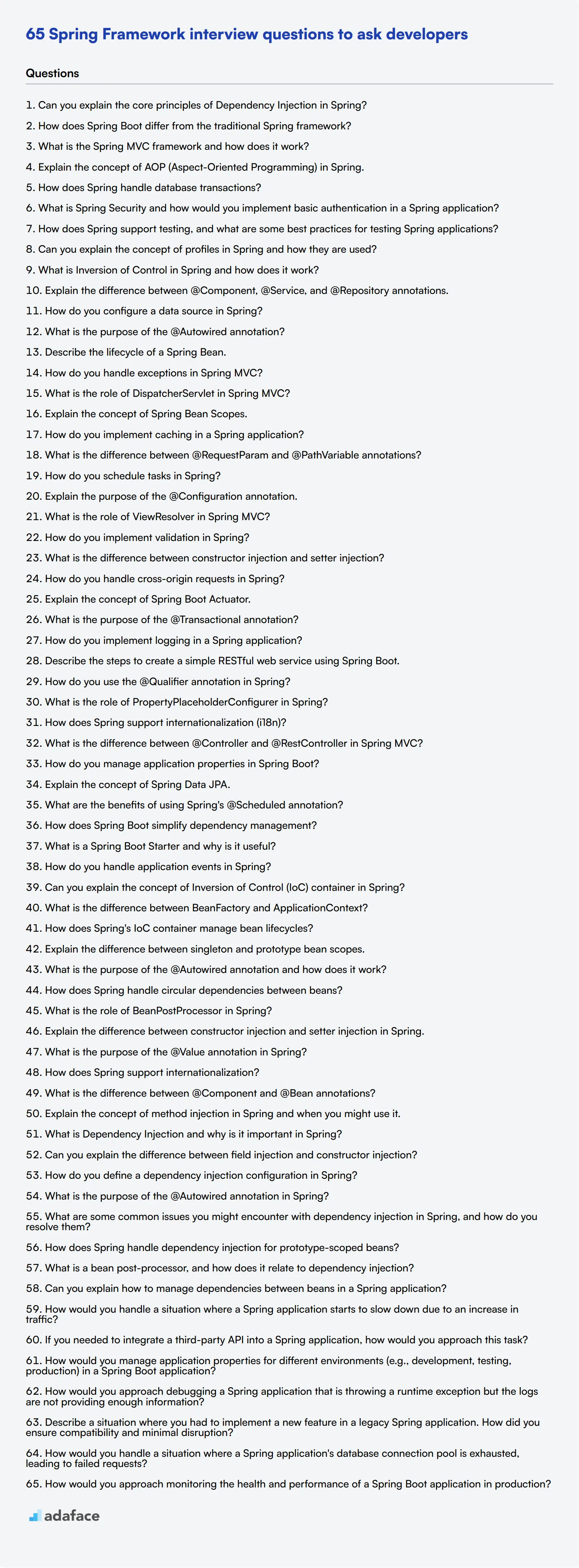Hiring the right Spring Framework developers can deeply impact your organization's success. Knowing what questions to ask during the interview process ensures you identify candidates with the right skills and experience required for software developers.
This blog post provides a curated list of interview questions tailored for different levels of Spring Framework knowledge. From junior to top-tier developers, these questions cover core concepts, dependency injection, and situational scenarios.
Using these questions will streamline your interview process and help you make informed hiring decisions. Consider complementing your interviews with a Spring test from Adaface to further validate candidates' skills.
Table of contents
Top 8 Spring Framework questions to ask in interviews
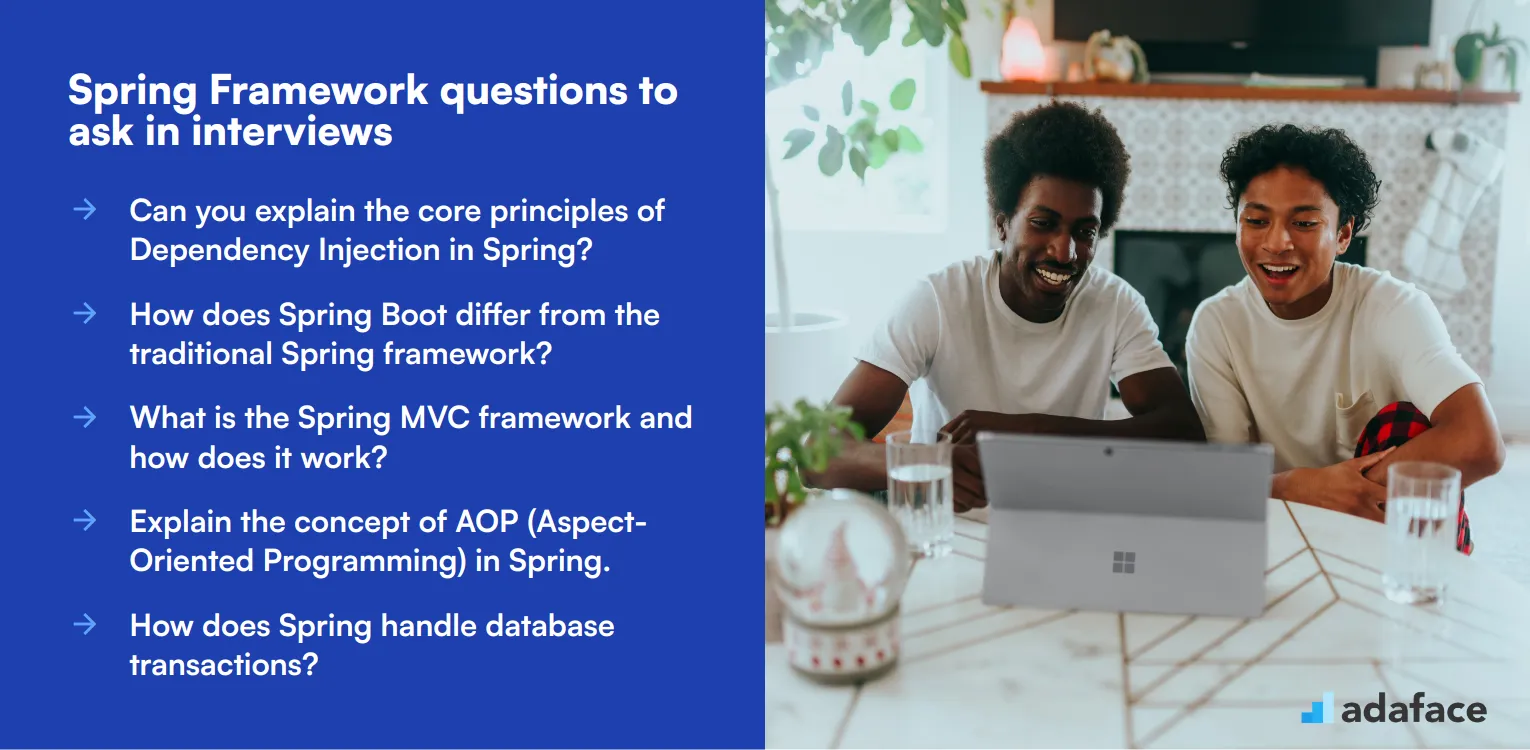
Ready to spring into action with your Spring Framework interviews? These top 8 questions will help you uncover candidates' true understanding of this powerful Java application framework. Use them to gauge both theoretical knowledge and practical experience, ensuring you find the right fit for your development team.
1. Can you explain the core principles of Dependency Injection in Spring?
A strong candidate should be able to explain that Dependency Injection (DI) is a core principle of Spring that allows objects to define their dependencies without creating them. This inversion of control (IoC) moves the responsibility of managing object creation and lifecycle to the Spring container.
They might elaborate on the benefits of DI, such as increased modularity, easier testing, and reduced boilerplate code. Look for mentions of different types of dependency injection, such as constructor injection, setter injection, and field injection.
Pay attention to candidates who can relate DI to real-world scenarios or discuss how it improves software architecture. Follow up by asking about their preferred method of DI and why they choose it in their projects.
2. How does Spring Boot differ from the traditional Spring framework?
A knowledgeable candidate should explain that Spring Boot is an extension of the Spring framework that simplifies the process of building production-ready applications. They should highlight key features like auto-configuration, embedded servers, and opinionated defaults.
Look for mentions of how Spring Boot reduces boilerplate code, speeds up development, and makes it easier to create standalone, production-grade Spring-based applications. Candidates might also discuss the 'convention over configuration' principle that Spring Boot follows.
Strong answers will include comparisons between traditional Spring and Spring Boot setups, potentially mentioning reduced XML configuration, easier dependency management, and quicker application startup times. Consider asking about their personal experiences with both to gauge practical understanding.
3. What is the Spring MVC framework and how does it work?
An ideal response should explain that Spring MVC (Model-View-Controller) is a web application framework built on the Spring framework. It follows the MVC design pattern to separate the application logic into Model (data), View (user interface), and Controller (request handling) components.
Candidates should describe the request processing workflow in Spring MVC, including the role of the DispatcherServlet, handler mapping, controllers, view resolvers, and views. They might also mention annotations like @Controller, @RequestMapping, and @ResponseBody.
Look for explanations of how Spring MVC facilitates the development of flexible and loosely coupled web applications. Ask follow-up questions about their experience in building RESTful services or handling form submissions using Spring MVC to assess practical knowledge.
4. Explain the concept of AOP (Aspect-Oriented Programming) in Spring.
A comprehensive answer should define AOP as a programming paradigm that allows separation of cross-cutting concerns from the main business logic of the application. In Spring, AOP is used to implement features like logging, security, and transaction management without cluttering the core business code.
Candidates should be able to explain key AOP concepts such as aspects, join points, pointcuts, and advice. They might discuss how AOP complements object-oriented programming and helps in achieving better modularity and maintainability in complex applications.
Look for practical examples of how the candidate has used AOP in their projects. Strong answers might include discussions on Spring's proxy-based AOP implementation or comparisons with native AspectJ. Consider asking about the performance implications of using AOP to gauge deeper understanding.
5. How does Spring handle database transactions?
A well-informed candidate should explain that Spring provides declarative transaction management through the @Transactional annotation and programmatic transaction management using the TransactionTemplate. They should mention that this abstraction works across different transaction APIs like JTA, JDBC, Hibernate, and JPA.
Look for discussions on transaction propagation, isolation levels, and how Spring's transaction management integrates with various data access technologies. Candidates might also mention the benefits of Spring's approach, such as consistent programming model across different transaction APIs and reduced boilerplate code.
Strong answers will include examples of how to configure transaction management in Spring applications and potential pitfalls to avoid. Consider asking about their experience in handling distributed transactions or optimizing transaction performance in high-load scenarios.
6. What is Spring Security and how would you implement basic authentication in a Spring application?
A good response should explain that Spring Security is a powerful and customizable authentication and access-control framework. Candidates should describe its core features, including protection against attacks like session fixation, clickjacking, and cross-site request forgery (CSRF).
For implementing basic authentication, they should mention configuring a SecurityFilterChain bean, specifying which URLs to secure, setting up user details service or connecting to an external identity provider, and possibly customizing the login process.
Look for candidates who can discuss different authentication methods (like form-based, JWT, or OAuth) and authorization strategies. Ask about their experience in implementing more complex security scenarios or integrating Spring Security with other application components to assess practical skills.
7. How does Spring support testing, and what are some best practices for testing Spring applications?
A knowledgeable candidate should highlight Spring's extensive support for unit and integration testing. They should mention the Spring TestContext Framework, which provides annotation-based testing support, and discuss features like dependency injection in test classes, transaction management, and caching.
Look for mentions of specific testing annotations like @SpringBootTest, @WebMvcTest, and @DataJpaTest. Candidates might also discuss the use of Mockito for mocking dependencies and JUnit for writing test cases.
Best practices they might mention include writing focused unit tests, using appropriate test slices for faster execution, setting up test data using @SQL or programmatically, and leveraging Spring Boot's test utilities. Consider asking about their approach to writing maintainable and efficient test suites for large Spring applications.
8. Can you explain the concept of profiles in Spring and how they are used?
A solid answer should explain that Spring profiles provide a way to segregate parts of application configuration and make them available only in certain environments. Candidates should describe how profiles can be used to manage different configurations for development, testing, and production environments.
They might discuss various ways to activate profiles, such as through properties files, JVM system properties, or programmatically. Look for mentions of the @Profile annotation and how it can be used on beans or configuration classes.
Strong responses will include practical examples of using profiles, such as configuring different data sources or enabling certain features only in specific environments. Consider asking about strategies for managing profile-specific properties or their experience in using profiles in large-scale applications to gauge deeper understanding.
20 Spring Framework interview questions to ask junior developers
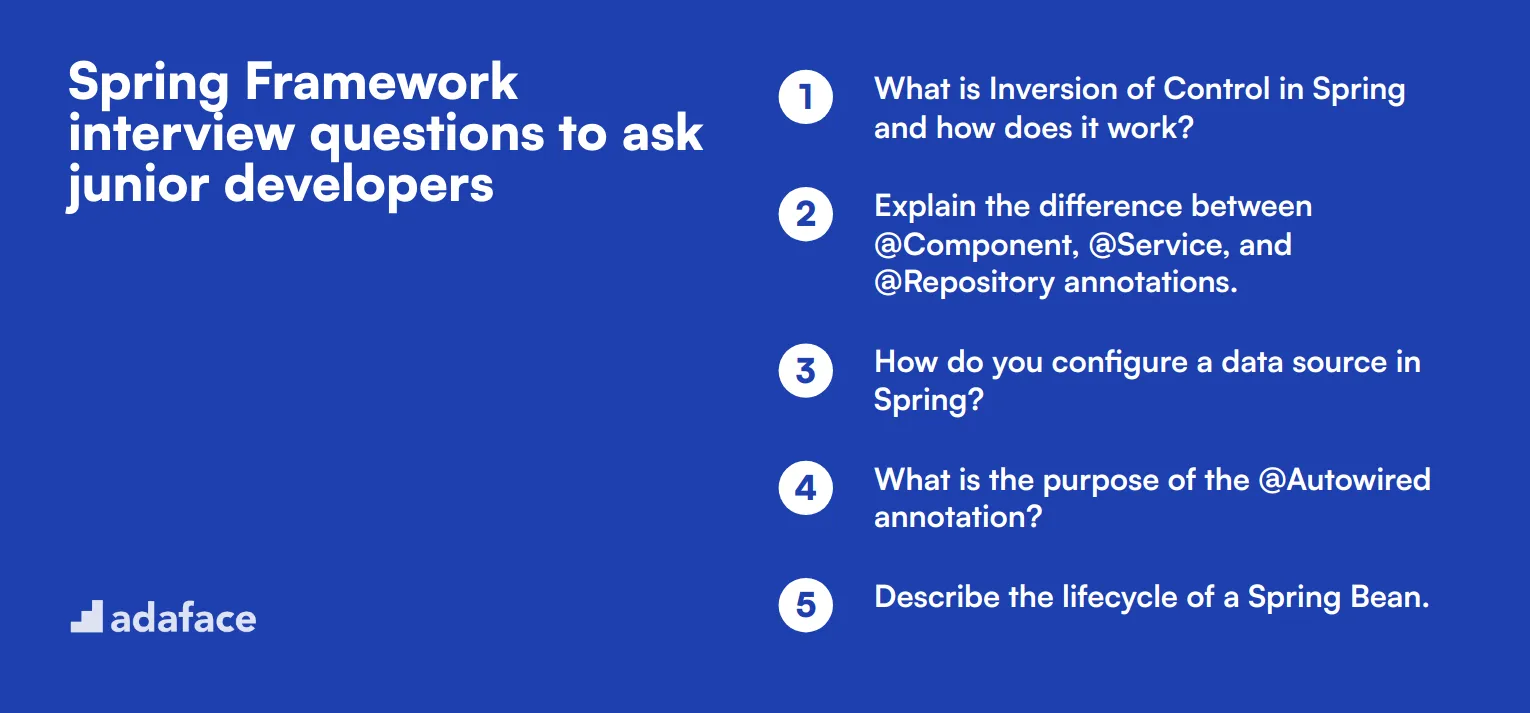
To assess the foundational knowledge of junior developers in Spring Framework, use these 20 interview questions. They cover key concepts and practical applications, helping you gauge a candidate's understanding and potential fit for your team.
- What is Inversion of Control in Spring and how does it work?
- Explain the difference between @Component, @Service, and @Repository annotations.
- How do you configure a data source in Spring?
- What is the purpose of the @Autowired annotation?
- Describe the lifecycle of a Spring Bean.
- How do you handle exceptions in Spring MVC?
- What is the role of DispatcherServlet in Spring MVC?
- Explain the concept of Spring Bean Scopes.
- How do you implement caching in a Spring application?
- What is the difference between @RequestParam and @PathVariable annotations?
- How do you schedule tasks in Spring?
- Explain the purpose of the @Configuration annotation.
- What is the role of ViewResolver in Spring MVC?
- How do you implement validation in Spring?
- What is the difference between constructor injection and setter injection?
- How do you handle cross-origin requests in Spring?
- Explain the concept of Spring Boot Actuator.
- What is the purpose of the @Transactional annotation?
- How do you implement logging in a Spring application?
- Describe the steps to create a simple RESTful web service using Spring Boot.
10 intermediate Spring Framework interview questions and answers to ask mid-tier developers
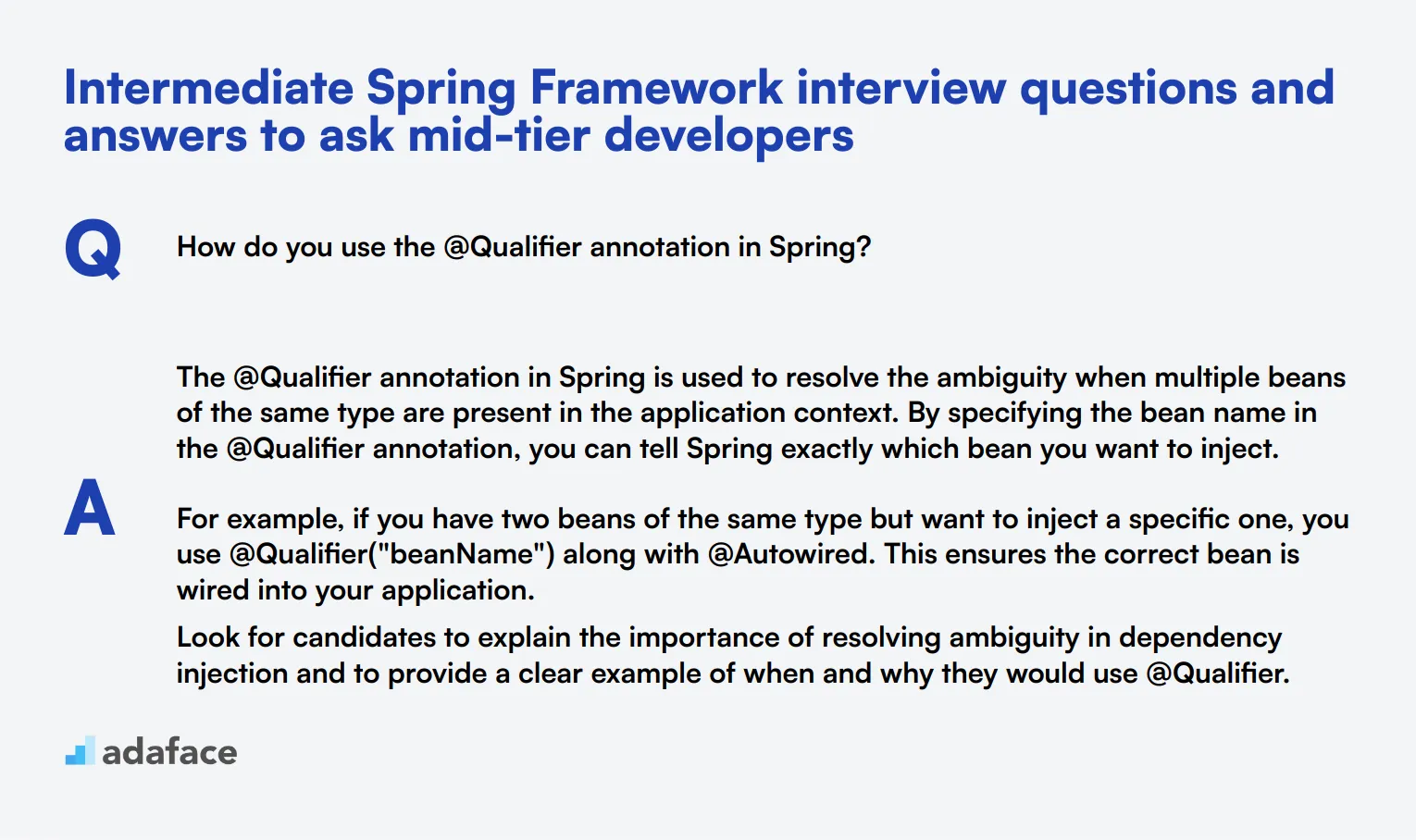
To determine whether your applicants have the right skills to handle intermediate-level tasks with the Spring Framework, ask them some of these 10 interview questions. They will help you gauge their understanding and ability to work effectively with this powerful framework.
1. How do you use the @Qualifier annotation in Spring?
The @Qualifier annotation in Spring is used to resolve the ambiguity when multiple beans of the same type are present in the application context. By specifying the bean name in the @Qualifier annotation, you can tell Spring exactly which bean you want to inject.
For example, if you have two beans of the same type but want to inject a specific one, you use @Qualifier("beanName") along with @Autowired. This ensures the correct bean is wired into your application.
Look for candidates to explain the importance of resolving ambiguity in dependency injection and to provide a clear example of when and why they would use @Qualifier.
2. What is the role of PropertyPlaceholderConfigurer in Spring?
PropertyPlaceholderConfigurer is a utility class in Spring that helps resolve ${...} placeholders within bean definition property values. It allows you to externalize configuration to properties files, which makes your application more flexible and easier to manage.
By defining PropertyPlaceholderConfigurer in your Spring configuration and specifying the location of your properties file, Spring will replace the placeholders with the corresponding values from the properties file at runtime.
Candidates should highlight how this feature helps in managing different environments (development, testing, production) and should demonstrate an understanding of the importance of externalizing configuration.
3. How does Spring support internationalization (i18n)?
Spring supports internationalization (i18n) through its built-in i18n support. It allows you to create applications that can present messages, texts, and other elements in multiple languages.
By using message source beans, typically ResourceBundleMessageSource, you can define messages in various properties files, each corresponding to a different locale. Spring automatically resolves the appropriate message based on the user's locale.
An ideal candidate should understand the significance of i18n in creating globally accessible applications and should describe how to configure and use message sources in Spring.
4. What is the difference between @Controller and @RestController in Spring MVC?
The @Controller annotation marks a class as a Spring MVC controller, which can handle HTTP requests and return views. Methods in a @Controller typically return view names, which are resolved by a ViewResolver to render HTML pages.
On the other hand, @RestController is a specialized version of @Controller that combines @Controller and @ResponseBody. It is used to create RESTful web services, and methods in a @RestController return data directly in the form of JSON or XML, rather than view names.
Look for candidates to explain the specific use cases for each annotation and to demonstrate an understanding of when to use @Controller versus @RestController based on the application's requirements.
5. How do you manage application properties in Spring Boot?
In Spring Boot, application properties are managed using the application.properties or application.yml file. These files allow you to define various configuration settings such as server port, database connections, and custom application properties.
Spring Boot automatically loads these files and makes the properties available for injection using the @Value annotation or through @ConfigurationProperties classes.
Candidates should mention the ease of managing configurations with Spring Boot and the flexibility of using different profiles for different environments by creating multiple property files like application-dev.properties and application-prod.properties.
6. Explain the concept of Spring Data JPA.
Spring Data JPA is a part of the larger Spring Data family, which aims to simplify data access and manipulation. It provides a repository abstraction over JPA (Java Persistence API), making it easier to create data access layers with minimal boilerplate code.
By extending interfaces such as JpaRepository or CrudRepository, you can leverage powerful CRUD operations and query methods without needing to write actual repository implementation classes.
Look for candidates to discuss the advantages of using Spring Data JPA, such as reduced boilerplate code, built-in query generation, and integration with other Spring components. They should also be able to describe how to set up and use Spring Data JPA in a project.
7. What are the benefits of using Spring's @Scheduled annotation?
The @Scheduled annotation in Spring is used to schedule tasks to run at fixed intervals or specified times. This is useful for automating repetitive tasks such as sending emails, cleaning up logs, or updating data.
You can use various scheduling options with @Scheduled, such as fixedRate, fixedDelay, and cron expressions, to specify how and when a task should run.
Candidates should explain the practical benefits of using @Scheduled, such as improved automation and reduced manual effort. They should also provide examples of scenarios where scheduled tasks are beneficial.
8. How does Spring Boot simplify dependency management?
Spring Boot simplifies dependency management by providing a set of curated dependencies, known as 'starters,' which you can include in your project. These starters bring in a predefined set of libraries and configurations needed for specific functionalities, such as web development, data access, and security.
By using starters, you avoid the hassle of manually managing individual dependencies and their versions. Spring Boot also leverages a dependency management plugin to ensure consistent versions across your project.
Ideal candidates should demonstrate an understanding of how starters streamline dependency management and should mention the convenience of using Spring Boot's curated dependencies to quickly set up new projects.
9. What is a Spring Boot Starter and why is it useful?
A Spring Boot Starter is a dependency descriptor that simplifies the inclusion of common libraries and configurations needed for a specific functionality in a Spring Boot application. Examples include spring-boot-starter-web for web applications and spring-boot-starter-data-jpa for JPA-based data access.
Starters are useful because they reduce the complexity of managing dependencies and configurations. By including a starter in your project, you automatically get all the necessary dependencies and configurations, allowing you to focus on writing business logic.
Candidates should highlight the convenience and efficiency that starters bring to Spring Boot development, and they should be able to provide examples of commonly used starters in their projects.
10. How do you handle application events in Spring?
In Spring, application events are a way to communicate between different parts of the application without tight coupling. You can define custom events by extending ApplicationEvent and publish them using ApplicationEventPublisher.
Listeners can be created by implementing the ApplicationListener interface or using the @EventListener annotation. These listeners will react to the published events and execute their logic accordingly.
Look for candidates to explain the benefits of using application events for decoupling components and to provide examples of scenarios where event-driven architecture can improve the application's design and maintainability.
12 Spring Framework questions related to core concepts
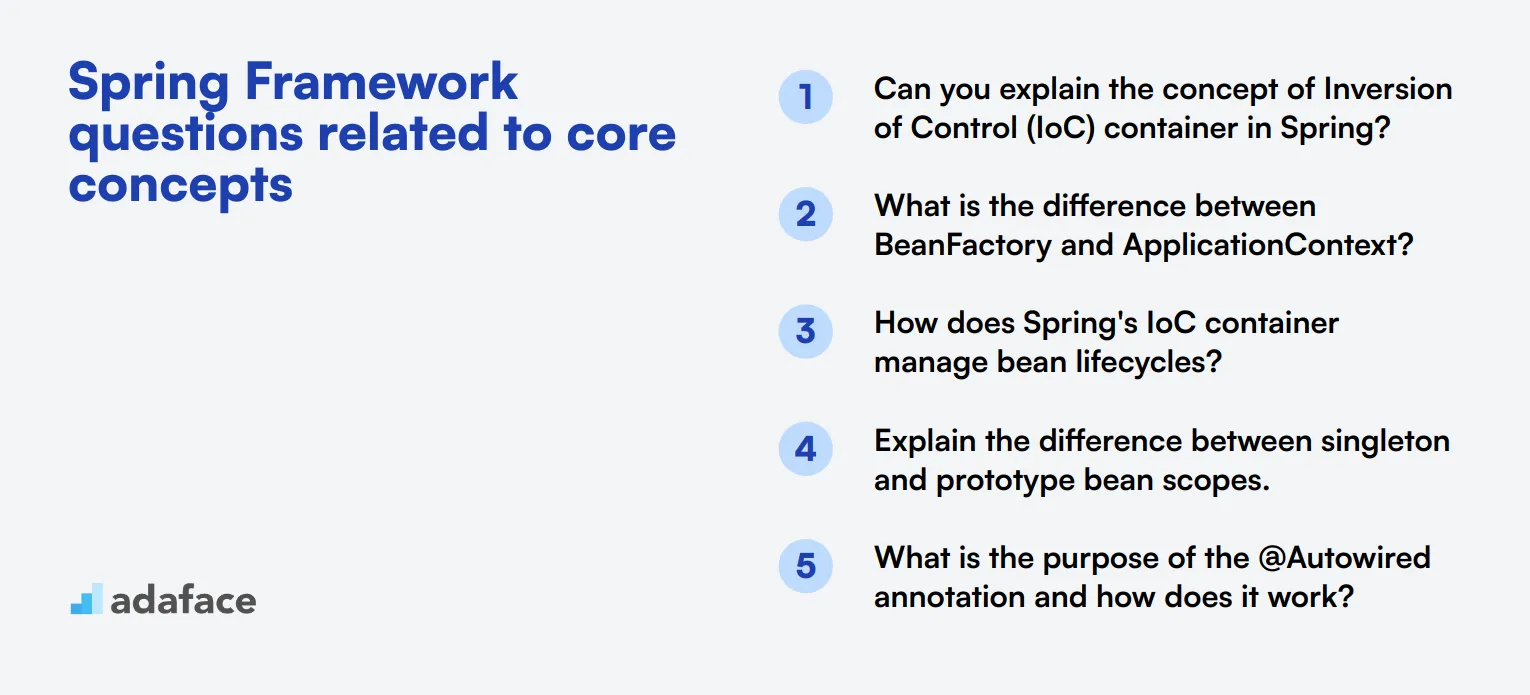
To assess a candidate's grasp of Spring Framework's core concepts, use these 12 targeted questions. They're designed to help you evaluate a Spring Boot developer's understanding of fundamental Spring principles, which are crucial for building robust and scalable applications.
- Can you explain the concept of Inversion of Control (IoC) container in Spring?
- What is the difference between BeanFactory and ApplicationContext?
- How does Spring's IoC container manage bean lifecycles?
- Explain the difference between singleton and prototype bean scopes.
- What is the purpose of the @Autowired annotation and how does it work?
- How does Spring handle circular dependencies between beans?
- What is the role of BeanPostProcessor in Spring?
- Explain the difference between constructor injection and setter injection in Spring.
- What is the purpose of the @Value annotation in Spring?
- How does Spring support internationalization?
- What is the difference between @Component and @Bean annotations?
- Explain the concept of method injection in Spring and when you might use it.
8 Spring Framework interview questions and answers related to dependency injection
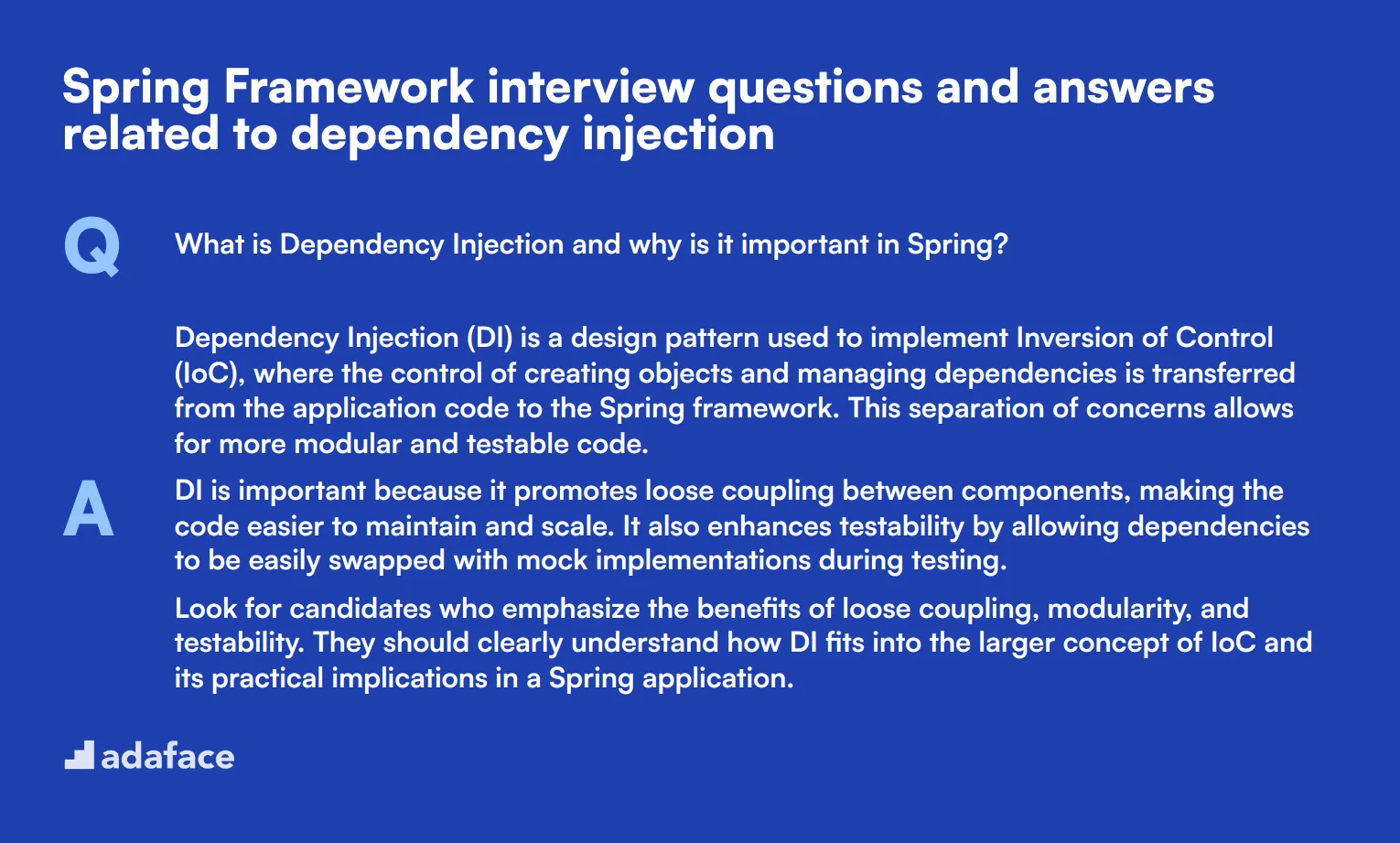
To determine whether your applicants have a solid grasp of dependency injection in the Spring Framework, use these carefully curated interview questions and answers. This list will help you identify candidates who can effectively manage dependencies and ensure your Spring applications are robust and maintainable.
1. What is Dependency Injection and why is it important in Spring?
Dependency Injection (DI) is a design pattern used to implement Inversion of Control (IoC), where the control of creating objects and managing dependencies is transferred from the application code to the Spring framework. This separation of concerns allows for more modular and testable code.
DI is important because it promotes loose coupling between components, making the code easier to maintain and scale. It also enhances testability by allowing dependencies to be easily swapped with mock implementations during testing.
Look for candidates who emphasize the benefits of loose coupling, modularity, and testability. They should clearly understand how DI fits into the larger concept of IoC and its practical implications in a Spring application.
2. Can you explain the difference between field injection and constructor injection?
Field injection involves injecting dependencies directly into the fields of a class using annotations like @Autowired. It is simple to use but can make it harder to identify dependencies and test the class in isolation.
Constructor injection, on the other hand, involves passing dependencies through a class constructor. This makes dependencies explicit and enforces the rule that a class should not be instantiated without its required dependencies.
Ideal responses will highlight the advantages of constructor injection, such as improved testability and explicit dependency declaration. Candidates should also be aware of the potential drawbacks of field injection, like hidden dependencies and reduced immutability.
3. How do you define a dependency injection configuration in Spring?
A dependency injection configuration in Spring can be defined using either XML configuration files or Java-based configuration classes annotated with @Configuration. In XML, beans and their dependencies are declared within <bean> elements. In Java, the @Bean annotation is used within a @Configuration class to define the beans and their relationships.
Java-based configuration is generally preferred for its type safety and ease of refactoring. It also supports more advanced features like conditional bean creation and profile-based configurations.
Look for candidates who can discuss both methods and explain why Java-based configuration is often considered more modern and maintainable. They should also mention practical scenarios where one might be preferred over the other.
4. What is the purpose of the @Autowired annotation in Spring?
The @Autowired annotation in Spring is used to mark a field, constructor, or setter method for dependency injection. When Spring's IoC container initializes a bean, it automatically injects the required dependencies into the marked fields or methods.
The @Autowired annotation can be used with optional attributes like required to indicate whether the dependency is mandatory or optional. This flexibility helps manage complex dependency graphs more effectively.
Candidates should demonstrate a clear understanding of how @Autowired works and discuss scenarios where it is beneficial. They should also be able to explain the potential pitfalls of overusing it, such as making the code less explicit and harder to test.
5. What are some common issues you might encounter with dependency injection in Spring, and how do you resolve them?
Common issues with dependency injection in Spring include circular dependencies, missing dependencies, and incorrect bean scopes. Circular dependencies occur when two or more beans depend on each other, leading to a loop that the IoC container cannot resolve. This can be fixed by using @Lazy or breaking the dependency cycle.
Missing dependencies often result in runtime errors. These can be resolved by ensuring all required beans are correctly defined and available in the application context. Incorrect bean scopes can lead to issues like shared state or excessive memory usage, which can be addressed by choosing the appropriate scope for each bean.
Strong answers will include specific examples of issues encountered and the strategies used to resolve them. Candidates should demonstrate problem-solving skills and a deep understanding of how the Spring IoC container manages dependencies.
6. How does Spring handle dependency injection for prototype-scoped beans?
In Spring, prototype-scoped beans are created each time they are requested, unlike singleton-scoped beans, which are created only once per Spring IoC container. This means that dependencies injected into prototype beans must be managed carefully to avoid shared state issues.
When a prototype bean is injected into a singleton bean, Spring does not create new instances automatically. To handle this, you can use ObjectFactory, Provider, or method injection with lookup methods to ensure a new instance is created whenever needed.
Candidates should explain the nuances of prototype scope and demonstrate an understanding of techniques to manage prototype beans effectively. Look for answers that mention real-world scenarios and potential pitfalls, such as unintended shared state.
7. What is a bean post-processor, and how does it relate to dependency injection?
A bean post-processor is a Spring framework interface that allows for custom modification of new bean instances after their creation but before their initialization. This is useful for tasks like injecting dependencies, custom initialization, or wrapping beans with proxies.
Bean post-processors can be used to implement custom dependency injection logic, validate bean properties, or apply AOP (Aspect-Oriented Programming) advice. They provide a way to hook into the bean lifecycle and customize the behavior of beans in a consistent manner.
Ideal candidates will understand the role of bean post-processors and provide examples of when and why they might be used. They should also discuss how post-processors can enhance dependency injection by adding custom logic to the bean creation process.
8. Can you explain how to manage dependencies between beans in a Spring application?
Dependencies between beans in a Spring application are managed using annotations like @Autowired, @Resource, and @Inject. These annotations can be used to specify which beans should be injected into a given bean, either by type or by name.
Spring also provides configuration options through XML or Java-based configurations to define dependencies explicitly. Additionally, the use of profiles allows for different sets of beans to be created based on the environment, making it easier to manage dependencies in different scenarios.
Look for candidates who can articulate the various ways to manage dependencies and discuss the pros and cons of each method. They should also mention best practices for organizing and maintaining bean configurations to ensure clarity and maintainability.
7 situational Spring Framework interview questions with answers for hiring top developers
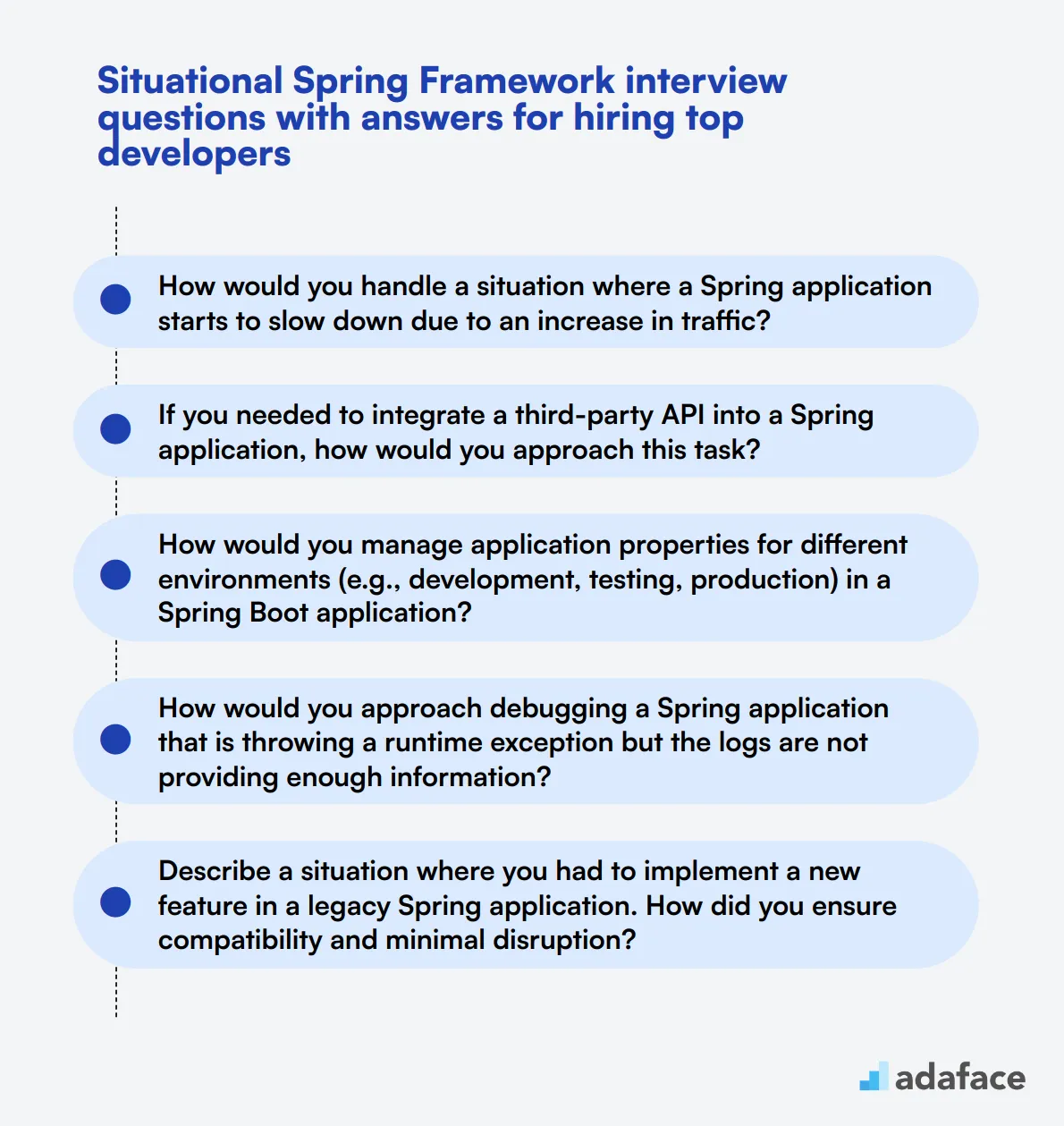
To hire top developers who can navigate real-world challenges, ask these situational Spring Framework interview questions. They will help you understand how candidates apply their knowledge in practical scenarios.
1. How would you handle a situation where a Spring application starts to slow down due to an increase in traffic?
To handle a slowdown due to increased traffic, I would start by analyzing the performance bottlenecks using profiling tools. This includes examining CPU, memory, and database usage.
Next, I would consider optimizing the most frequently used parts of the application, such as refactoring code, optimizing database queries, and implementing caching. Load balancing and horizontal scaling might also be necessary to distribute the traffic more effectively.
Look for candidates who mention specific tools and strategies they have used in the past. Follow up by asking about a real-world example where they improved application performance.
2. If you needed to integrate a third-party API into a Spring application, how would you approach this task?
To integrate a third-party API, I would start by reviewing the API documentation to understand the available endpoints and required authentication methods. I would then use Spring's RestTemplate or WebClient to handle HTTP requests and responses.
I would also configure appropriate error handling and logging to ensure that the integration is robust and easy to debug. If the API requires authentication, I would securely manage API keys or tokens.
An ideal candidate should demonstrate an understanding of RESTful principles and mention any relevant experience with APIs. Ask them to describe any challenges they faced during similar integrations.
3. How would you manage application properties for different environments (e.g., development, testing, production) in a Spring Boot application?
In a Spring Boot application, I would manage application properties by using different property files for each environment (e.g., application-dev.properties, application-test.properties). These files can be activated using Spring profiles.
I would also use environment variables and command-line arguments to override properties when deploying to different environments. This ensures that sensitive information like database credentials is not hardcoded.
Look for candidates who emphasize security and flexibility in their approach. Follow up by asking how they have implemented configuration management in their previous projects.
4. How would you approach debugging a Spring application that is throwing a runtime exception but the logs are not providing enough information?
To debug a Spring application with insufficient log information, I would first increase the logging level to DEBUG or TRACE to get more detailed logs. I would also add custom log statements at key points in the code to track the application's flow.
If the issue is still unclear, I would use a debugger to step through the code and inspect variable values. Tools like JConsole or VisualVM can help monitor JVM performance and identify potential issues.
Candidates should show a systematic approach to debugging and mention any tools they find useful. Ask for an example of a challenging bug they resolved and how they went about it.
5. Describe a situation where you had to implement a new feature in a legacy Spring application. How did you ensure compatibility and minimal disruption?
When implementing a new feature in a legacy Spring application, I would start by understanding the existing codebase and dependencies. I would write unit and integration tests to ensure that the current functionality is not broken.
I would then implement the new feature in a modular way, using dependency injection to minimize coupling. After implementation, I would run the tests and perform regression testing to verify that the new feature works as expected without disrupting existing functionality.
Strong candidates should emphasize testing and modular design. Follow up by asking how they handled any challenges related to integrating new features into legacy systems.
6. How would you handle a situation where a Spring application's database connection pool is exhausted, leading to failed requests?
To handle an exhausted database connection pool, I would first analyze the application's database usage patterns to understand why connections are not being released. This might involve reviewing transaction management and ensuring that connections are properly closed.
I would also consider increasing the size of the connection pool and implementing connection pooling parameters like maximum wait time and idle timeout. Monitoring tools can help track pool usage and identify bottlenecks.
An ideal candidate should mention specific tools and strategies they have used to manage database connections. Ask them about their experience with database connection pooling in a production environment.
7. How would you approach monitoring the health and performance of a Spring Boot application in production?
To monitor the health and performance of a Spring Boot application, I would use Spring Boot Actuator to expose endpoints that provide metrics, health checks, and application information. These endpoints can be integrated with monitoring tools like Prometheus and Grafana.
I would also set up alerts for key metrics like CPU usage, memory usage, and response times to proactively address any issues. Logging frameworks like Logback can be configured to capture detailed logs for analysis.
Candidates should show a comprehensive approach to monitoring and mention any specific tools they have used. Follow up by asking how they responded to a performance issue in a past project.
Which Spring Framework skills should you evaluate during the interview phase?
While it's challenging to fully gauge a candidate's expertise in a single interview, focusing on key Spring Framework skills can provide valuable insights. These specific skills are the most relevant for assessing whether a candidate can effectively contribute to projects using Spring.
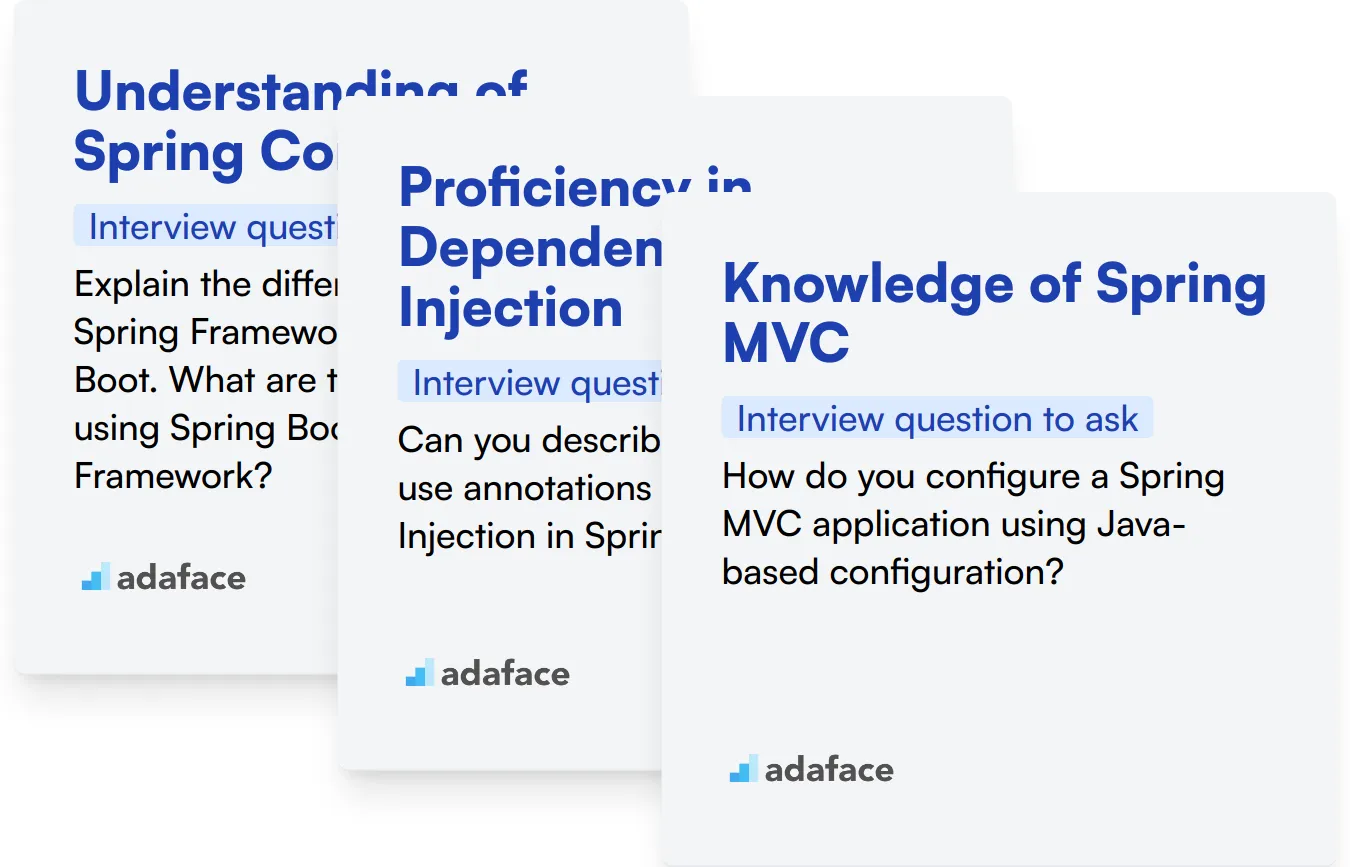
Understanding of Spring Core and Spring Boot
A thorough understanding of Spring Core and Spring Boot is fundamental as these are the backbone of most Spring applications. Mastery of these areas ensures a developer can effectively set up and configure Spring applications, leading to streamlined development processes.
To efficiently assess this skill, consider utilizing a tailored assessment test that includes relevant MCQs. Our Spring Test is designed to help filter candidates with the necessary foundational knowledge in Spring Core and Spring Boot.
To further evaluate this skill, pose specific interview questions that delve into the practical application of these frameworks.
Explain the difference between Spring Framework and Spring Boot. What are the advantages of using Spring Boot over Spring Framework?
Look for detailed explanations that highlight understanding of auto-configuration, standalone applications, and how Spring Boot simplifies the use of Spring.
Proficiency in Dependency Injection
Dependency Injection (DI) is a key aspect of Spring, promoting loose coupling and greater testability. This skill is indicative of a candidate’s ability to write clean, manageable, and modular code.
Utilizing a multi-choice quiz can help pre-screen candidates for their understanding of DI principles. While Adaface does not currently have a specific test for only DI, our comprehensive Spring Test includes questions covering this important topic.
During the interview, ask questions that assess the candidate's ability to implement DI in a Spring context.
Can you describe how you would use annotations for Dependency Injection in Spring?
Candidates should demonstrate a clear understanding of annotations like @Autowired and @Qualifier, and explain scenarios in which each is used.
Knowledge of Spring MVC
Spring MVC is crucial for developing web applications. A solid grasp of this framework indicates the candidate's ability to handle complex web development tasks with Spring.
You can verify this skill with MCQs that focus on Spring MVC concepts. Consider using our Spring Test, which includes specific sections on Spring MVC to ensure candidates' proficiency.
In the interview, pose a challenging question that tests the practical application of Spring MVC.
How do you configure a Spring MVC application using Java-based configuration?
The answer should involve details about @Configuration, @EnableWebMvc, and how to define ViewResolvers or MessageConverters.
Hire top talent with Spring Framework skills tests and the right interview questions
When hiring for positions that require Spring Framework skills, it's important to ensure candidates possess the necessary expertise. A thorough evaluation of their technical abilities can save time and resources in the recruitment process.
One effective way to assess these skills is through targeted skills tests. Consider using our Java Spring Test to accurately measure a candidate's proficiency and understanding of Spring Framework concepts.
After administering the test, you will be able to shortlist the best applicants based on their performance. This allows you to focus your interview efforts on candidates who are likely to excel in the role.
To get started, visit our test library or sign up at Adaface to access a variety of assessments tailored for your hiring needs.
Spring Online Test
Download Spring Framework interview questions template in multiple formats
Spring Framework Interview Questions FAQs
The questions cover junior, mid-tier, and senior developer levels, allowing you to assess candidates across various experience ranges.
Use a mix of questions from different categories to get a well-rounded view of the candidate's Spring Framework knowledge and practical skills.
Yes, the list includes situational Spring Framework questions to assess how candidates apply their knowledge to real-world scenarios.
It's a good practice to review and update your question set annually or when significant changes occur in the Spring Framework ecosystem.

40 min skill tests.
No trick questions.
Accurate shortlisting.
We make it easy for you to find the best candidates in your pipeline with a 40 min skills test.
Try for freeRelated posts
Free resources




